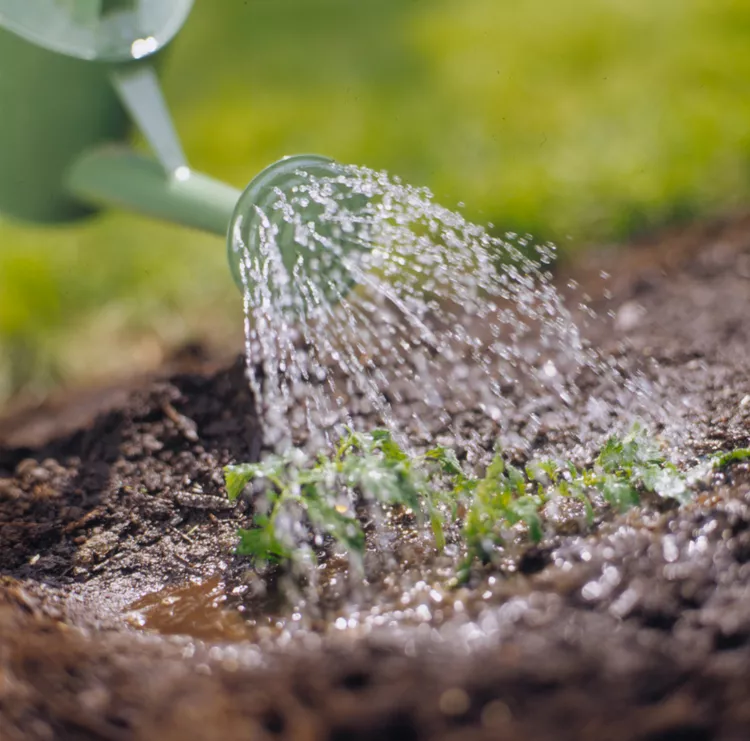7 Watering Mistakes That Could Sabotage Your Vegetable Garden

How do you know when to water your vegetables and how much water to apply? It's not difficult, but there are specific nuances to watering vegetables that you should know about to make the most of your watering efforts. For example, watering seedlings is different from watering established vegetable plants. Watering in-ground beds differs from watering containers. And watering in the morning is better than watering at noon.
Understanding these differences will maximize your watering efficiency. Here are the most serious mistakes to avoid, so your vegetables get all the water they need for a healthy harvest.
1. Under or overwatering seedlings.
Because they're just developing their roots, newly planted and young seedlings require a steady supply of moisture—don't let them dry out! Water seedbeds lightly every morning and recheck them in the evening. If a dry crust forms on the soil surface, it can be difficult for new seeds to germinate. And if a germinating seed dries out, it may die.
On the other hand, don't let the soil get too soggy; overwatering a seedbed can promote diseases such as damping off, a fungus that kills young seedlings. The key is to maintain an evenly moist—not wet—soil until the young plants have developed healthy roots.
2. Not knowing how often to water a vegetable garden.
You must know how often to water an actively growing vegetable garden for successful plant growth. Frequent light watering may perk up your plants in the short term but also promotes shallow root growth. This causes plants to dry out quickly when the soil surface dries, which can happen fast on a hot, sunny day.
It's better to water less often, but to water deeply by slowly letting water percolate down several inches in the soil. This encourages roots to grow down beyond the top couple of inches, where they're better protected from rapid moisture fluctuations and less likely to dry out. Deep soaking two to three times a week—considering rainfall—will promote healthier, more productive growth than frequent shallow watering.
The best way to know if your vegetable garden needs water is to stick your finger down into the soil a couple of inches. If it feels dry, water. If the soil feels moist, hold off another day or two.
3. Not using a rain gauge.
Most warm-season vegetable plants grown in the ground need about an inch of water each week, whether from rain or irrigation. Of course, that depends on your soil—sandy soil dries more quickly than heavy clay soil. (Raised beds and container gardens need more water—see below). Keep track of the amount of rain your garden is getting by using a rain gauge; record rainfall amounts (jotting a note in your garden journal works) so that you know how often to water your vegetable garden for additional moisture.
4. Under-watering containers and raised beds.
Vegetables and herbs grown in containers or raised beds need water more often than in-ground beds. Why? First, the soil mixture used in containers and raised beds is designed to drain more quickly than the soil of an in-ground bed. Secondly, because their soil is above ground level, the temperature rises quickly on warm days, increasing evaporation.
Check the moisture level in your containers and raised beds regularly by sticking a moisture meter or finger a couple of inches into the soil. If the soil is dry, it's time to water.
5. Watering during the heat of the day.
The best time to water your garden is in the morning when leaves that may get wet have plenty of time to dry before night. Watering during the day's heat is less efficient; water evaporates faster and less reaches the root zone. In the evening, when temperatures drop, evaporation slows again, but cooler night temperatures also favor the spread of some foliar diseases. If you must water in the evening, avoid wetting leaves.
6. Wetting leaves.
Plants get their moisture through their roots, not their leaves. Direct watering to the soil surface and avoid wetting leaves because water helps spread some plant diseases. Use a watering wand to reach ground level or a soaker hose or trickle irrigation system to wet the soil rather than the leaves.
7. Splashing soil onto leaves.
The soil can harbor many plant diseases. If your watering efforts splash soil onto the leaves of your plants, those diseases can spread, so use a gentle spray or a soaker hose. In addition, a two-inch layer of mulch around your crop, prone to several foliar diseases, such as tomatoes, helps prevent soil from getting splashed around when you water or when it rains.